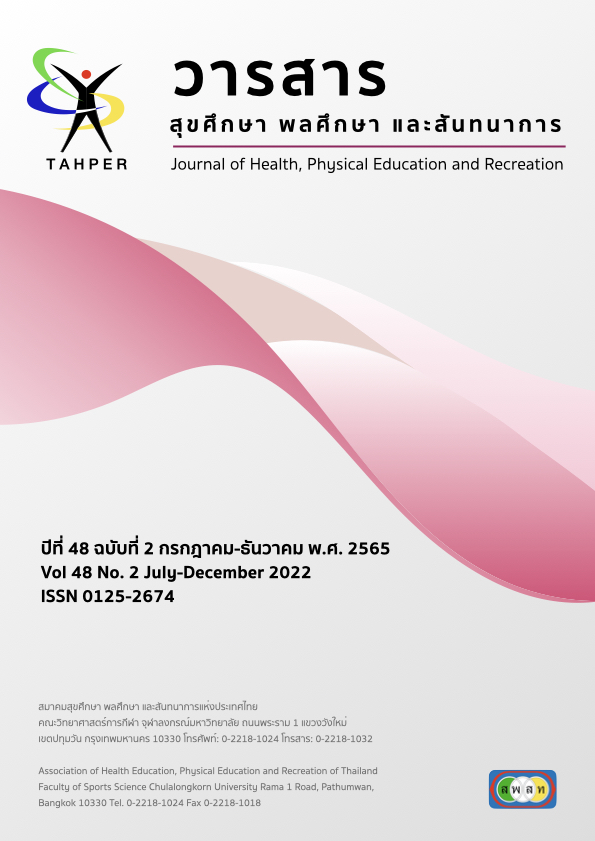ความสัมพันธ์ระหว่างสมดุลชีวิตในการทำงานและความสุข ในการทำงานของนักกีฬาอาชีพ Relationship Between Work-Life Balance and Work Happiness of Professional Athletes
Main Article Content
Abstract
บทคัดย่อ
การวิจัยครั้งนี้มีวัตถุประสงค์ เพื่อเปรียบเทียบระดับของสมดุลชีวิตในการทำงานและความสุขในการทำงานของนักกีฬาอาชีพ และเพื่อศึกษาความสัมพันธ์ระหว่างสมดุลชีวิตในการทำงานและความสุขในการทำงานในภาพรวม จำแนกตามประเภทกีฬาและอายุ กลุ่มตัวอย่างเป็นนักกีฬาอาชีพ เนื่องจากความหลากหลายของชนิดกีฬาและการเข้าถึงกลุ่มประชากร จึงได้ทำการคำนวณขนาดของกลุ่มตัวอย่าง จากสูตรไม่ทราบขนาดกลุ่มตัวอย่างของ Cochran และเลือกแบบกำหนดโควตากำหนดสัดส่วนตามประเภทกีฬา โดยให้โควตากีฬาประเภททีมต่อกีฬาประเภทเดี่ยว 3:1 ซึ่งกลุ่มตัวอย่างนักกีฬาประเภททีม 316 คน และประเภทเดี่ยว 102 คน รวม 418 คน เครื่องมือที่ใช้ แบบวัดสมดุลชีวิตในการทำงาน และแบบวัดความสุขในการทำงาน สถิติที่ใช้วิเคราะห์ข้อมูล ได้แก่ ค่าเฉลี่ย ส่วนเบี่ยงเบนมาตรฐาน ร้อยละ การทดสอบค่าที วิเคราะห์ความแปรปรวนทางเดียว เปรียบเทียบรายคู่โดยใช้การทดสอบด้วยวิธีการ LSD (Least Significant Difference) และการวิเคราะห์หาค่าสัมประสิทธิ์สหสัมพันธ์แบบเพียร์สัน โดยกำหนดนัยสำคัญทางสถิติที่ระดับ .05
ผลการวิจัยพบว่า 1) นักกีฬาอาชีพประเภททีมมีระดับสมดุลชีวิตการทำงาน ด้านการทำงานและสังคม แตกต่างกัน อย่างมีนัยสำคัญทางสถิติที่ระดับ .05 โดยนักกีฬาอาชีพประเภททีมมีสมดุลชีวิตในการทำงาน ด้านการทำงานและสังคมสูงกว่านักกีฬาอาชีพประเภทเดี่ยว 2) นักกีฬาอาชีพ มีช่วงอายุที่แตกต่างกัน มีระดับสมดุลชีวิตในการทำงาน แตกต่างกัน อย่างมีนัยสำคัญทางสถิติที่ระดับ .05 นักกีฬาอาชีพ มีช่วงอายุที่แตกต่างกัน มีระดับความสุขในการทำงานที่แตกต่างกัน อย่างมีนัยสำคัญทางสถิติที่ระดับ .05 และ 3) สมดุลชีวิตในการทำงานของนักกีฬาอาชีพ มีความสัมพันธ์กัน กับความสุขในการทำงานของนักกีฬาอาชีพ อย่างมีนัยสำคัญทางสถิติที่ระดับ .05 และในรายด้าน ด้านตนเองและครอบครัว และด้านการทำงานและสังคม มีความสัมพันธ์กัน กับความสุขในการทำงานของนักกีฬาอาชีพ อย่างมีนัยสำคัญทางสถิติที่ระดับ .05
คำสำคัญ : ความสุขในการทำงาน, สมดุลชีวิตในการทำงาน, การทำงานของนักกีฬาอาชีพ
Abstract
This research is aimed to compare the level of work-life balance and work happiness of professional athletes and to study the relationship between work-life balance and overall work happiness in Classified by type of sports and age. The samples were professional athletes. Due to the diversity of sports and access to demographic groups. Therefore, the sample size was calculated rom the formula of the unknown sample size of Cochran and chose a quota sampling model to determine the proportion according to the sport type by giving a team sports quota per single sport 3:1, which the sample group of 316 team athletes and 102 singles athletes, totaling 418 people. The tools consisted of the questionnaire about work life balance scale and work happiness scale. The statistics used for data analysis were mean, standard deviation, percentage, and t-test. One-way ANOVA of pairs using the least significant difference test and Pearson's correlation coefficient analysis with statistical significance at the level of .05
The study's findings were as follows: 1) professional athletes of the type of team have a level of work-life balance in terms of work and society; there was a statistically significant difference at the level of.05. Work and social aspects are higher than for single professional athletes. 2) professional athletes have different age ranges. There are various levels of work-life balance, with statistical significance at the level of .05. Professional athletes’ range in age have different levels of work happiness, with statistical significance at the level of.05, and 3) the work life balance of professional athletes is related to the happiness in the work of professional athletes with statistical significance at the level of .05, and in terms of self and family and work and society is related to the happiness in the work of professional athletes with statistical significance at the level of .05.
Keywords: Work-Life Balance/ Work Happiness/ Professional Athletes
Article Details

This work is licensed under a Creative Commons Attribution-NonCommercial-NoDerivatives 4.0 International License.
Critical thinking in journals is the right of the author. The Association of Health Education, Physical Education and Recreation of Thailand is not always required, to create diversity in ideas and creativity.
ความคิด ข้อวิพากษ์ในวารสารเป้นสิทธิของผู้เขียน สมาคมสุขศึกษา พลศึกษา และสันทนาการแห่งประเทศไทยไม่จำเป็นต้องเห็นชอบด้วยเสมอไป เพื่อให้เกิดความหลากหลายในความคิดและความสร้างสรรค์


